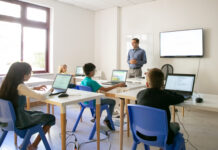Introduction
Media is the platform of mass communication; it is also used to store and deliver data. In the 21st century, the word media refers to many platforms, like digital media, mass media, news media, multimedia, cinema, publishing, advertising. Media will help the students to communicate and learn. The early-stage of communication media is through cave painting, pottery painting, sculpture, and early writings then it evolves to writing on paper and mailing it to long-distance, in this 21st century a revolution in telecommunication has made a path of communication and lead to a new era of media like social media, digital media, multimedia, etc. with this development in the media and communication students can easily communicate with their teachers and friends. In the book “Counterblast” (1954) Canadian communication theorist Marshall McLuhan used the term media “The media are not toys; they should not be in the hands of Mother Goose and Peter Pan executives. They can be entrusted only to new artists because they are art forms.”(McLuhan,2004) The term medium is the plural to media, it is the common ground to the general communication and information platforms.
In the book “Teachers Discovering Computers – Integrating Technology and Digital Media in the Classroom” by Gary B. Shelly, Thomas J. Cashman, Glenda A. Gunter, and Randolph Gunter “digital media is defined as those technologies that allow users to create new forms of interaction, expression, communication, and entertainment in a digital format.”(Cashman and Shelly,2007). Multimedia is a communication platform that includes many content forms like video, animation, audio, images, texts in a single presentation. Media had a significant impact on students’ life and plays a major role in education. Media is created to cover a large audience. Today media is made its place in the essentials like food, shelter media also deeply involved in human life. Media also made an impact on society, education, politics, etc. The media help to know spread education and information to all, digital media and social media make the news to travel around the world. Universities and educational instructions have computer labs, televisions, projectors, smart boards, laptops / personal computers, tablets, etc, and including them in the curriculum makes the students to interpret data from the media.
Modern media like social media and digital media are made the educational fieldwork remotely, every student can afford access to the digital media. It can be used in both classes and at home to enhance the learning process in any discipline.
Media in Language Learning
In the present century media is everywhere and everything, it became part of our daily life. Media has the strength to change personalities, change the way we observe and understand the world. There are two types of media print media and electronic media, print media are newspapers, magazines, books, and other printed materials and electronic media like the internet, radio, television, films, etc. Media is the most powerful tool; it can change the world with a single message. Media play a major role in the learning and teaching process.
Print media is the initial stage of technological development in media, print media like newspaper, the book is the basic and old form of communication, these are the only source before the early 21st century. Even in the 21st century, many country’s educational systems are based on the printed study materials. In printed media the universal access is limited and consumes more time, it is being printed in every region language to facilitate the readers to get information and also printed translated versions, so the readers can also learn about foreign cultures. Printed newspapers can give us news and information in the local or foreign languages, newspaper is the best way to educate the language learners and other students, it helps the language students to improve their vocabulary and communication skills. Although printed materials are outdated many teachers and scholars recommend reading the printed materials.
Electronic media is a developed stage of media, learners can get information and data from the radio, television, internet, computers. Radio and television help students to learn the new language from foreign channels and also their native languages. In television and radio, they conduct talk shows by inviting professors, scholars as a guest. Computers, the internet gave access to many materials, courses, now anyone can learn any language or subjects remotely and get a degree or certificate.
Digital Media and Multimedia in education
Digital media in education is the digital form of multimedia used in the classroom environment, we can attach digital products like software, devices, and platforms for learning. It plays important role in education and communication. Digital media has the power to stimulate imagination and critical thinking skills it makes own learning for the students possible; it also makes more success. Digital media platforms like email, video, photos, slideshows, websites, can be used to enhance the classroom environment. More students and teachers are encouraging digital media classes because the classes will help the students to interact, students will watch the videos and understand the concept of the lesson in a short time. Students have a short time to write down the notes and they can’t keep track of the entire lessons, so tools like video, screen recorder, digital notes will help them to tie up with their lessons. Digital media make the learning process simpler, even a student with difficulties can be good at studies.
Social Media in language learning
Social media is a group of social internet-based applications in education that helps students and teachers to get more information. Technology development was only focused on students’ needs maximum students use any of social media platforms, so the development of social media in education is necessary for this generation. Using social media in language learning provides students with more relevant and useful information and social media also connect the student with many learning groups and they can also connect with many other educational systems. Students can use social media for language learning, they can connect with fellow language learners and students can also connect and chat with the native language speaker. In this era, educational institutions encourage and connect with students using social media. Students can connect with the experts in the language or other subjects using social media platforms, when students start to connect with experts, they can gain more useful content. Educational instructions use social media platforms to connect with students, parents, and teachers. Parents and teachers can track student’s activity, they can see the timeline of the usage of the platforms. The email was the first social media included in the education process, it helped students to contact their teachers.
Using digital and social media tools and platforms for language learning
Using video and video editing software will help the teachers to teach their students and make them more interactive in their classes. If we analyze every student in the class they are expecting to be visually stimulated, even below-average students are responding well to their classes if their teacher use video to teach them. Teachers can also use video tools to create and edit the video according to his theory. It is very hard for the students to keep track of their lessons and they are given only a short time to write notes, but if a student engages to watch video lessons they can understand it deeply and the study says that students can understand video classes and modules more than traditional teaching methods. Videos can make the language learners to understand the speaker’s pronunciation and their accent. Teachers can encourage the student to understand the video without sound or playing the video in a foreign language, it helps them to think creatively. Students expect something new, teachers can use a small video clip of introduction to the topic.
By using audio and podcasts students can recall the subject the teachers tough them in classrooms, audio and podcasts also help visually challenged students. If a student starts a project or research, a self-audio recording will help them to speed the brainstorming process. Language learners can record their audio and listen to it to avoid further errors, they can use audios and podcasts to understand the accent and fluent of the native language speakers.
Pictures and image editing tools will help the teacher to teach their student the seeing the exact portrait of the lessons, if the teacher teaches the poem “Ought to a nightingale”, the teacher can show the image of the nightingale and the background scenery, so the student can feel the nature of the poem. By displaying images or digital images allow students to imagine and help them to think creatively. It also helps students to recall the lesson when they needed it. There are many royalty and copyright-free websites for free images, so the teachers and students can use them to collect the images.
Blogs are small weblogs or online journals. It is the best way to gain more knowledge and an easy way to self-learn. Teachers use blog platforms to publish materials, resources, assignments, they can also use them to help students master content and improve their writing skills. Students can use free platforms like bloggers, edublog, or WordPress to publish their writing.
E-book and Pdf platforms help the students to get free books and materials on one device, it can be downloaded and store anywhere with a digital device. E-Books and pdf can be shared with anyone. If the student feels uncomfortable or unable to read the text, they can use read-aloud future. Students need not buy all the books recommended to their curriculum, they can just download the eBooks on his device like mobile phones or laptops or tablets, or kindle. It is Environment friendly too, it eliminates using a paper process. We can easily get a pdf copy of research forums from the journal websites.
Communication platforms help both teachers and students to interact with each other. Using email and other messaging software can help to connect students and teachers after the class. In the communication process social media plays a major role, it is the best platform for the students to get connected with teachers. Both students and teachers can use Email to send and receive files and messages. There are many messaging apps for free, so communication between students and teachers can be strong. Using social media platform teacher can study student’s mentality and the environment because in this era every student was on any one of the social media platforms.
Using Search engines students can find anything they want by just typing the word or phrase. The search engine is the container of many websites and social media platforms, so the student can get any information he wants in a second. Teachers and students can use search engines anytime they want, and the answer will receive them in less time comparing to searching books and materials in the library.
By using Job portals and professional forums students can follow and chat with professionals and great peoples, in these portals, the professionals will post important information and quotes. Portals like LinkedIn have every professionals and language speaker in the world, so it is very easy to connect with them.
Writing tools like Microsoft word and google Documents editor made typing simple, with these tools students can write books, journals, magazines, etc. Using some plugins makes translation, correction, and screen recording easy, students can translate a whole page or a letter in one click, they can also use these tools to write or take notes. Auto-correction plugins make the students write error-free texts. Screen recording will help them to monitor his typing speed and errors he made while writing.
The infographics tool will help the students to memorize or understand the concept of the chapter or lesson. Students cannot understand the concept of the chapter by just reading the texts, they like to see it in the visual. Teachers can use infographics to illustrate a timeline, to create awareness, to highlight important statistics, to offer step-by-step instructions. By incorporating infographics into a learning activity, a teacher can introduce a module and convey the basics of the module by using an infographic.
Text to speech is a tool used to convert typed text into voice generated by the computer, it helps students with dyslexia or struggling to learn the language. There are many free text-to-speech software on the internet, just need to select the perfect one. Teachers can use text to speech software to create obstacles with the printed or digital text materials and help their students with reading issues. This tool will improve the student’s word recognition skills, improve the student’s focus and make them to remember the information for a long time, students can focus on both sound of words and comprehension.
Digital storytelling tools and software will help the teachers to transform their thoughts and ideas into a concrete form, so students can visually understand the concept that teachers are trying to convey. Students always like to hear, watch and tell stories, so a story is an easy way to attract students. Behmer stated, “Storytelling is a process where students personalize what they learn and construct their own meaning and knowledge from the stories they hear and tell”(Behmer,2005). By using software like adobe slate teachers can create a visual story, with colourful background illustrations.
By conducting surveys, quizzes, tests, and assessments through digital media will help the teachers to test their student’s skills. Language teachers can make their students to watch videos or giving a passage and asking a question from it will help them to listen or read the given content and. Before starting the lesson, the teacher can create digital polls or quizzes to the knowledge of the subject. Digital quizzes, surveys, tests, and assessments will create more interactive sessions.
Screen capturing tools and software help teachers and students to capture important notes or subjects. Using a screen capturing / recording tool gives us a sharable image or video content, during online classes teacher can record or take a snapshot on the screen, so a teacher can share the material and record for further study or for an absent student. Students can use these recordings and images for homework.
Social bookmarking is an online platform where students can add, edit and share bookmarks of digital documents. This tool help students to identify the specific category of websites and web content easily. The tool will save the necessary content what the student or teacher referred to. Tools like eLearning Tags will help the teachers and students to share, discuss, vote, and discovering the content.
Bibliography and citation tools will help students to gather, cite and study sources for their projects, thesis and essays. Platforms like BibMe and Citation Machine will help teachers, students, and research scholars to crew a citation according to chosen styles like MLA or APA. These tools will help researchers to scroll important websites needed for their work and it also helps them to check plagiarism. This tool will be useful for researchers.
Note-taking using digital devices will help the students to take references or important points. If a student writes due to lack of time his written work will have errors and the handwriting may awful, even the student can’t remember what he/she wrote, but by using digital note-taking tools or platforms students can take short note or voice note or video note or image note. Digital note-taking has seen perfect in laptops and computers more than a tablet and mobile phones, due to the small screen and lack of keyboard. Digital note-taking tools have text-to-speech options it so just student or teacher need to spell the word. Most importantly digital notes are easily saveable and sharable
Authoring is the tool that helps teachers to create digital content and make them an eLearning format, then they can share it through learning management systems. Every authoring tool has its own special features because it is designed and developed by different companies. By using authoring tools teachers can create lessons, they can add, edit and create images, texts, videos, slides, audio. This tool makes the eLearning more interactive, like including games or activities in the platform. Teachers can use this tool easily by using premade templates.
Annotation tools are used to type text and draw, it is used to draw attention to the content teachers are teaching. Teachers can use these tools to highlight or mark the important content which students want to focus on. In this platform they give many tools for the teachers to teach, tools like a pointer, selection, calligraphy, oval, square, colour, and eraser are commonly used and given on every platform. Students can also collaborate and use these tools along with their teachers.
Cloud storage and cloud computing help students and teachers to store, share the contents, materials in large size. Cloud computing helps both teachers and students to use a cloud computer, if a student can’t afford a personal computer or laptop he can use his mobile phone to buy cloud computing access. Cloud storage has the best usability and accessibility every student and teacher can easily use and access the cloud by using the internet. Security and privacy in these cloud platforms will be high it will be encrypted end to end. Every student can afford free cloud storage and computing but they give only limited access and limited storage for extra we must pay money but the cost also affordable for every student and teacher.













